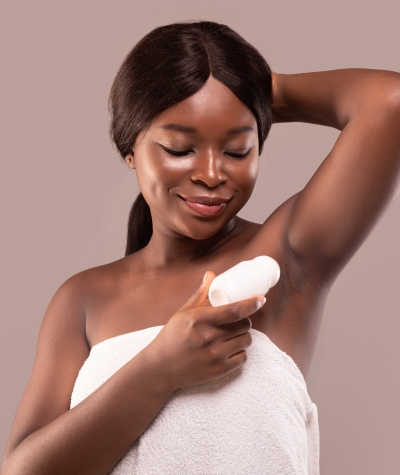In this section:
- Understanding how we sweat
- How the products work
- Are deodorants and antiperspirants safe?
- New innovations
Understanding how we sweat
Every day we produce on average one litre of sweat. Our skin contains millions of glands, and it is some of these that produce sweat. When we are hot, active, nervous or stressed, our sweat glands are stimulated to produce more sweat. As sweat evaporates from our skin, it absorbs heat energy from our body and so cools us down.
We have between 25,000 and 50,000 sweat glands in our armpits alone, although this is actually only a small percentage of our total. But the sweat is more likely to get trapped under our arms and can't escape - and so it is more noticeable here.
This is when bacteria start to feed off the sweat and create body odour. Sweat itself doesn't actually smell at all.
There are two types of sweat glands on our bodies - eccrine and apocrine. The former are all over our body and control temperature. The latter are concentrated in certain areas, such as the armpits, and can be triggered by stress. This 'emotional' sweating can be a problem because about double the amount of moisture is released. This means more for the bacteria to feed on and so greater body odour.
How the products work
Most antiperspirants contain ingredients called aluminium salts. The main way in which they work is to dissolve in sweat and create a thin coating of gel to cover over the sweat glands. This coating reduces the amount of sweat released onto the surface of the skin for a number of hours after the antiperspirant is applied.
Deodorants can be used under the arm or all over the body (as bodysprays) to control body odour. Deodorants use ingredients such as alcohol and antimicrobials to kill bacteria and include fragrance to mask bad smells.
Are deodorants and antiperspirants safe?
The safety of antiperspirants has been raised several times, either saying that the blockage of sweat ducts leads to a "build up of toxins" or that aluminium itself is dangerous to use in this type of product.
In the first case, we do not excrete toxins through our sweat ducts but, predominantly, through the liver and kidneys and into the urine or faeces. If toxins were eliminated in sweat, people living in cold climates could be at a distinct disadvantage. Underarm sweat is only a small proportion of the total sweat lost through the skin each day that we are not normally aware of.
Aluminium is the third most abundant element in the earth and it is found naturally in our food and drinking water as well as in some pharmaceutical products. The overwhelming mass of safety data available does not indicate any risk of harmful effects from using any cosmetic products that contain aluminium.
A number of leading cancer research organisations have stated there is no plausible biological mechanism by which antiperspirants could cause breast cancer. Indeed in the past, national cancer charities and other authorities (including Breakthrough Breast Cancer and Cancer Research UK) have seen false allegations as detracting from the search for the true causative factors or as diverting attention away from taking action on those factors known to be associated with a risk of breast cancer.
New innovations
Some recent deodorants have been developed so that the fragrance is released over a long period of time. Fragrance is enclosed in tiny micro-spheres of corn starch which break open, releasing a smell when saturated with sweat. Smaller micro-spheres will release fragrance straight away; larger ones will break down more slowly.
New products have also been specifically designed to reduce white marks. For example, the product is developed to affect the way that light is bounced off the skin so that there is less visible white powder.

